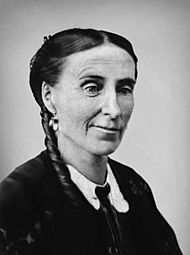Frances Browne facts for kids
Quick facts for kids
Frances Browne
|
|
|---|---|

From the Family Collection of Selwyn Glynn Brisbane Australia
|
|
| Born | 16 January 1816 Stranorlar, County Donegal, Ireland |
| Died | 21 August 1879 (aged 63) Richmond, Surrey, England |
Frances Browne (born January 16, 1816 – died August 21, 1879) was a talented Irish writer. She wrote many poems and novels. She is best known for her wonderful collection of short stories for kids called Granny's Wonderful Chair.
Her Early Life
Frances Browne was born in Stranorlar, County Donegal, Ireland. She was the seventh of twelve children in her family. When she was just 18 months old, she became blind. This happened because she had an illness called smallpox.
Even though she couldn't see, Frances was very determined. She learned by listening carefully. Her brothers and sisters would read their lessons aloud every evening. Frances would listen and remember everything. She even did their chores to get them to read to her! She worked very hard to memorize all the stories and information she heard.
Frances wrote her first poem when she was seven years old. It was her own version of "The Lord's Prayer".
Becoming a Published Writer
Frances Browne's first poems were published in 1841. They appeared in magazines like the Irish Penny Journal and the London Athenaeum. One of her poems, "Songs of Our Land," became very popular. You can still find it in books of Irish patriotic poems.
She published her first book of poems in 1844. A second book followed in 1847. Newspapers, especially the Northern Whig in Belfast, often printed her work. People started calling her 'The Blind Poetess of Ulster'.
In 1845, Frances began writing for a popular magazine called Chambers's Edinburgh Journal. She wrote for them for the next 25 years! Her first story there was "The Lost New Year's Gift." It was about a poor dressmaker in London. This story showed how good she was at telling tales.
She also wrote short stories for magazines that many women read. For example, she wrote for the Ladies' Companion in the 1850s. This magazine was popular with well-off women in the Victorian era. Some of her fun stories included "Mrs Sloper's Swan." She also wrote an exciting story set in County Fermanagh called "The Botheration of Ballymore."
Moving to New Cities
In 1847, Frances left Donegal and moved to Edinburgh, Scotland. Her sister came with her to help. Her sister would read to her and write down what Frances said. Even though Frances had health problems, she quickly became part of the literary scene. She wrote essays, reviews, stories, and poems.
In 1852, she moved to London. There, she wrote her first novel, My Share of the World, which came out in 1861. Her most famous book, Granny's Wonderful Chair, was published in 1856. This book is still printed today and has been translated into many languages. It's a collection of amazing fairy stories.
Also in 1856, her third book of poetry was released. It was called Pictures and Songs of Home. This book was for very young children and had beautiful pictures. The poems in it were about her childhood in County Donegal. They described the countryside there in a lovely way.
Later Life in London
After moving to London, Frances Browne wrote a lot for magazines from the Religious Tract Society. These included The Leisure Hour and The Sunday at Home. One of her stories in The Leisure Hour was "1776: a tale of the American War of Independence." This story came out in 1876, exactly 100 years after the American Revolution began. It described some of the events of the war. It was also a love story and had beautiful pictures.
Frances Browne's very last piece of writing was a poem called "The Children's Day." It was published in The Sunday at Home in 1879.
Frances Browne passed away on August 21, 1879, in Richmond upon Thames. She was buried in Richmond Cemetery a few days later.

